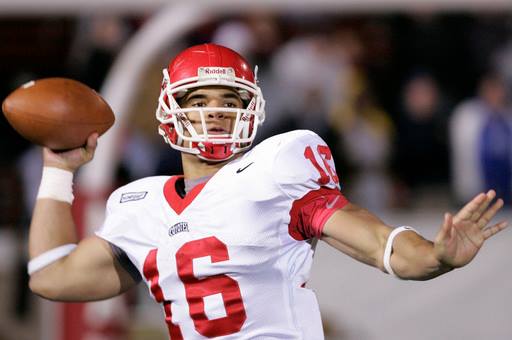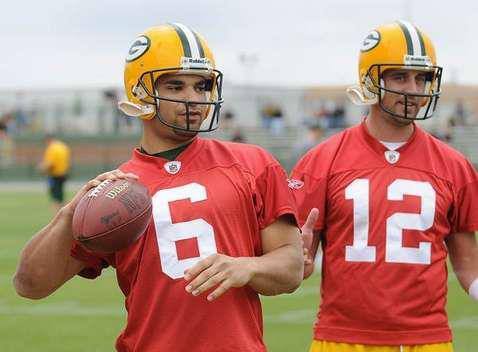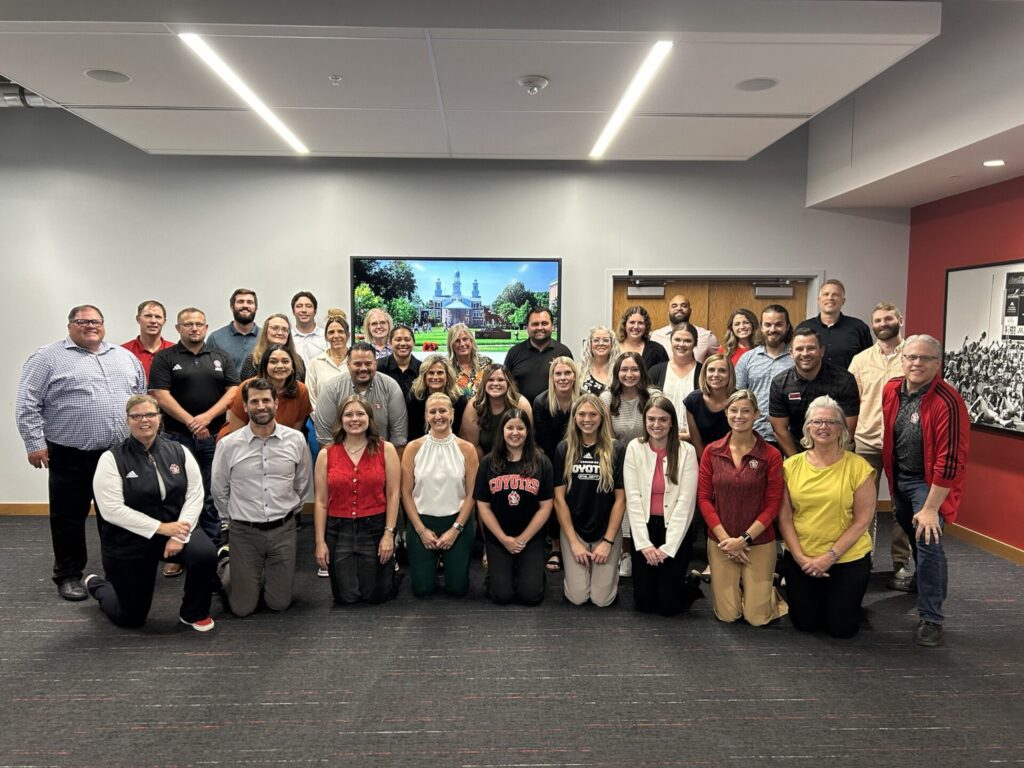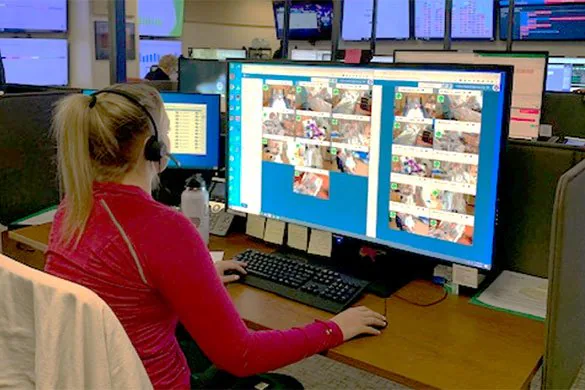Megan Ciampo knew only one person in South Dakota — but that was all it took for an experience that ultimately prompted the New Yorker to move to Sioux Falls.
The first visit was after the 2021 baseball season. Ciampo had risen to an assistant general manager of a team similar to the Sioux Falls Canaries and needed a break.

“With long hours and very few days off while working in professional baseball, I tried to end every season with a trip somewhere,” she said.
While other years had brought visits to the Jersey Shore or Massachusetts, in 2021 — she was 27 at the time — it was Sioux Falls.
“During that trip, I was surprised at how much there was to do in the city but wasn’t sold on moving here,” she said.
“It was only a couple months later when I was job searching that I decided to just see what was available. I had seen the Sanford Health all over during my first visit, so when I saw an opening that I was interested in, I applied. Even then, I didn’t think I would be moving here – but then I went through a few rounds of interviews, flew back to Sioux Falls for another weekend and was sold.”

That was in 2022. Two years later, she’s still often asked “Why Sioux Falls?”
“I’m still not sure if I have the answer,” Ciampo said. “My response was always just ‘why not?’”
At the time, though, “it was the most terrifying and rewarding decision I’ve ever made,” she added. “There was a lot of back and forth before I did it. Every conversation ended with ‘if you hate it, you can move home,’ so I took the risk and haven’t regretted it.”
Ciampo’s early career has been filled with variety. She worked in a busy New York City newsroom, wrote a novel and spent almost six years with the New York Boulders baseball team.

Her job as a content strategist with Sanford Health has been a rewarding one, she said.
“The people I get to work with are so incredible and have welcomed me into South Dakota with open arms,” she said. “I love that I get to help tell real stories from real people that we’ve seen time and time again make a real difference for people in our communities throughout the Sanford footprint.”
Not only that, but her co-workers have become friends.
“One thing that people don’t tell you often is that making friends as an adult isn’t very easy, especially when you come from a place much different than the place you currently live,” she said.
“Thankfully, the people I work with every day are all around my age, and we all get along really well, so that made the meeting people part of making friends a bit easier. I’m still learning how to put myself out there, and I’m trying to get better at asking people if they want to grab lunch or drinks or hang out.”

She first spotted an apartment that caught her eye when interviewing for a job and was able to move into it shortly after she relocated.
“I’m in the southeastern part of town, and I’m really happy with my decision to live in that area. I’m still renting and still in the same apartment that I initially moved into – mostly because the thought of moving all of my clothes sounds exhausting!” she said.
“But I’m constantly keeping an eye on what’s available to hopefully buy my own place relatively soon, likely somewhere in the same area.”
On the weekends, you can find Ciampo exploring her new metro area or taking in a baseball game.

“I try to go to any craft fairs or festivals within driving distance,” she said. “I’ve been to a few, including Buffalo Days in Luverne, Quarry Days in Dell Rapids, Harrisburg Days, Riverboat Days in Yankton, Saturday in the Park in Tea and Junkstock in Omaha.”
2024 has been a big year for Ciampo, who turns 30 soon.
A highlight was participating in the latest cohort of EmBe’s Women’s Leadership Program.
“I didn’t know what to expect going into it, but it’s been a great learning experience for me, and I’m really looking forward to continuing to implement the things I’ve learned into my day-to-day work and personal life.”
This month, Ciampo looked back on one of the most impactful days and years of her life: Sept. 11, 2001.
She was 6 years old “when the world stopped turning” and her dad, a firefighter, responded to a call from the World Trade Center.

This marked the first year in the past 23 that she didn’t spend Sept. 11 at home with family. Instead, she gave those in her new home a powerful glimpse into the day’s lasting impact.
A second grader, she remembers being picked up on an unseasonably warm, bright day during recess at school.
“We all thought we were being pulled out early to go to an amusement park or somewhere fun,” she said.
“The next few weeks were a blur, but I remember my mom always had our portable house phone in her hand or within eyesight, waiting for a phone call that thankfully never came.”

Her father finally came home Sept. 22, 2001 — his 40th birthday.
“I remember being so excited to see him. Only recently did I look at the photos from that day and realize that his eyes are hollow and blank,” she said. “Like any good father would, he didn’t let his 6- and 9-year-old daughters catch on that he had just spent 11 days around death and destruction. He spent the day with us, thanked us for his gifts, probably let us stay awake longer than we should have, and then he went back to New York City and back to recovering victims from ‘the pile.’”

Sharing her story was a way “to honor the day and share a piece of what the day means with my co-workers and the Sioux Falls community,” Ciampo said.

Twenty-three years later, more than 11,000 members of the FDNY are experiencing some kind of World Trade Center illness. Out of that, more than 3,500 are suffering with a form of cancer.
“A year ago, my dad became one of the 3,500 after being diagnosed with metastatic squamous cell carcinoma from that Tuesday morning in 2001 and years of exposure afterwards,” she said. “Last year, instead of spending the day at memorial services, he spent Sept. 11 in a full day of radiation and chemotherapy.”

Read Ciampo’s full message on her personal blog.
“I really wanted to just drive home that this was an event that happened to real people and real families, and it wasn’t a one-day event. It’s been 23 years, and my family, and so many other families, are still feeling the impacts every day.”
Being away from family isn’t easy, she added. Ciampo relies on FaceTime and flies home frequently.

Ciampo with her family in New York
But she’s increasingly at home in Sioux Falls too.
“The people have been so welcoming and kind. It’s also been so fun to see how quickly the city is growing,” she said.
Ciampo’s story is a powerful example of how young professionals are connecting in the Sioux Falls community, said Denise Guzzetta, vice president of talent and workforce development for the Sioux Falls Development Foundation.
“We couldn’t be happier to see how Megan is finding personal growth and professional opportunities in Sioux Falls,” Guzzetta said. “Her family’s legacy of service is something that is resonating in Sioux Falls and will even more so as people learn her background and experience. She’s exactly the sort of person we need bringing her talent and life experience to Sioux Falls as our community grows.”
For Ciampo, “I’m excited to see how that continues and am excited to have it as part of my story,” she said. “I have absolutely no idea what to expect in the next few years because I couldn’t have predicted the last few years!”
To learn more about making Sioux Falls part of your story, email deniseg@siouxfalls.com.

















































